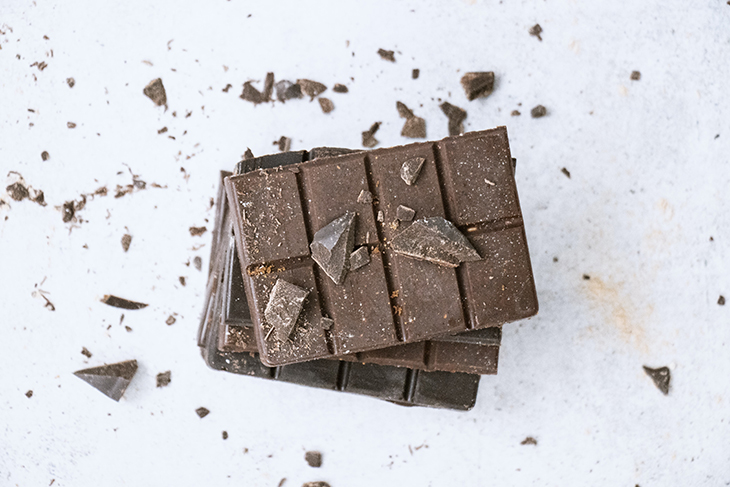
Recent research from Consumer Reports reveals a potential health concern in various chocolate products, indicating the presence of harmful amounts of heavy metals. This includes not only dark chocolate but also milk chocolate, cocoa powders, brownie mixes, and chocolate chips.
The study involved the analysis of 48 products, encompassing cocoa powder, chocolate chips, milk chocolate bars, brownie and cake mixes, and hot chocolate, sourced from both major brands such as Hershey’s, Nestlé, and Ghirardelli, as well as smaller brands like Droste and Navitas. These products were available at national retailers, including Costco, Trader Joe’s Target, Walmart, and Whole Foods.
The researchers focused on measuring levels of lead and cadmium in these chocolate products. As expected, the study found that dark chocolate products generally exhibited higher levels of heavy metals compared to milk chocolate.
The director and acting head of product safety testing at Consumer Reports, James Rogers, PhD, said in a statement, “But every product we tested had detectable amounts of lead and cadmium. Sixteen of the 48 products had amounts above Consumer Reports’ levels of concern for at least one of the heavy metals — in some cases more than twice our limit — but we did find safer options in each category of chocolate products.”
Your Favorite Chocolate Probably Has Lead and Cadmium
The research aimed to determine whether the analyzed chocolate products exceeded the maximum dose levels permitted in California, where environmental and safety regulations are often more stringent than federal standards.
As per Consumer Reports, the maximum daily allowable doses in California are 0.5 micrograms (mcg) for lead and 4.1 mcg for cadmium. Surprisingly, five out of the seven dark chocolate bars tested exceeded these maximum daily levels for lead, cadmium, or both.
The study identified specific products, such as the Evolved Signature Dark 72 Percent Cacao Chocolate Bar, which surpassed the limits for both lead and cadmium. These findings raise concerns about potential health risks associated with the consumption of certain dark chocolate products.
In contrast, all five milk chocolate bars tested had lead and cadmium levels below the daily limits per ounce. Notably, Lindt Classic Recipe Milk Chocolate Bar, Feastables Mr. Beast Bar Milk Chocolate, 365 Whole Foods Market Organic Milk Chocolate, Chocolove Milk Chocolate, and Hershey’s Milk Chocolate Bar were within the acceptable limits.
The analysis also covered chocolate chips and cocoa powders. None of the chocolate chips tested had high cadmium levels, but two products – Hu Dark Chocolate Gems and Good & Gather Semi-Sweet Mini Chocolate Chips – exceeded the lead limit. It’s important to note that these measurements were based on a serving size of about half an ounce.
Cadmium levels in cocoa powders were generally low, with only two products, one from Hershey’s and one from Droste, showing elevated lead levels. However, the serving sizes for these cocoa powders were just 1 tablespoon (tbsp).
The study extended its analysis to hot cocoa mixes, with four out of six products exceeding the limit for lead or cadmium. Notably, Ghirardelli Premium Hot Cocoa Mix and Swiss Miss Milk Chocolate Flavor Hot Cocoa remained below the limits for both heavy metals.
While most brownie mixes were within the acceptable limits, Ghirardelli Premium Brownie Mix Double Chocolate was found to be high in lead. Two out of six cake mixes, namely Simple Mills Almond Flour Baking Mix Chocolate Muffin & Cake and Bob’s Red Mill Gluten-Free Chocolate Cake Mix, exceeded the lead limit.
How Do Cadmium and Lead End Up in Chocolate and Why Are they Bad for You?
Cadmium, a naturally occurring mineral found in the Earth’s crust, is also present in cigarette smoke and utilized in various consumer and industrial applications such as batteries, pigments, metal coatings, and plastics. Exposure to cadmium occurs through the consumption of contaminated foods and inhalation of polluted air. Ingesting cadmium can result in vomiting and diarrhea, while inhalation may lead to kidney damage, fragile bones, and an increased risk of certain cancers.
Similarly, lead is naturally found in the Earth’s crust and, despite being banned in gasoline and paints in the United States, persists in various metal mixtures and industrial products like ammunition, older pipes, car radiators, glass and pottery. Exposure to lead can happen through air inhalation, consumption of contaminated food or beverages, and ingestion of dust or dirt containing lead. Young children are particularly at risk, facing potential developmental and cognitive problems due to lead exposure.
The presence of cadmium and lead in chocolate is attributed to different processes. Cadmium is naturally present in the soil where cacao beans grow, being absorbed by the plant during its growth. On the other hand, lead-containing dust appears to settle on the beans after harvesting and during the drying process in the sun.
Do I Need to Be Extra Worried About Heavy Metals in Chocolate?
Experts emphasize the importance of moderation in chocolate consumption. Luz Claduio, PhD, a professor of environmental medicine and public health, suggests that consumers don’t need to eliminate chocolate entirely from their diet.
Dr. Claudio says that the best approach is to eat a balanced diet with a variety of foods, including occasional sweets. “The most important components of a balanced diet are the consumption of fruits and vegetables with some lean proteins.”
Nutritionist Toby Amidor, RD, emphasizes that heavy metals are present in various foods, and awareness of overall dietary choices is crucial. As the chocolate industry grapples with these findings, consumers are encouraged to stay informed and make informed choices about their chocolate consumption.
She says, “Other foods actually have more cadmium, including leafy greens, whole grains, and potatoes, because they get it from the soil. However, you don’t hear any concern about those foods — and as a dietitian those are foods I recommend to keep in a healthy diet.”
“Eating the recommended one ounce of dark chocolate every so often isn’t likely to be harmful, or even if you eat a whole bar,” she adds.



